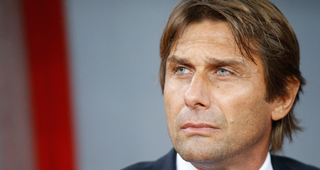Antonio Conte does enjoy the challenge of reawakening sleeping giants. He took over Juventus in 2011 after the club finished seventh in Serie A the previous season. He took the Italian national team job after failing to get out of their group in the 2014 World Cup. He’ll take over Chelsea next season after the side finished in 10th place. You can’t blame his ambition - after all, Juventus didn’t lose a single match in domestic play in his first season as manager.
And they won the league by nine points the following season, allowing just 24 goals. That season gave Conte his first experience as a manager in the Champions League. It started out well, as Juventus won its group featuring Chelsea, Shakhtar Donetsk and FC Nordsjaelland. Then, and most relevant to the upcoming European Championships, the side ran into trouble against Bayern Munich in the round of 16.
The match reports from the 2013 are telling. Conte insisted that his side would play without fear the first leg in Germany, and sent him team out in the controversial 3-5-2 formation (more on this later). But it was Bayern Munich, under Jupp Heynckes, who displayed the Conte-esque characteristics of a mobile and muscular side (the midfield duo of Javi Martinez, replaced by Luiz Gustavo in the opening leg, and Bastian Schweinsteiger were the most balanced in Europe that season, with equal parts brain and brawn). With Bayern Munich’s energetic press cutting off supply to Juventus’ strikers, the German club came away with a two-goal lead.
In his post match tactical analysis, Michael Cox emphasized a weakness specific to the 3-5-2 formation Conte played: they had no player assigned to deal with the attacking wing threat of Philipp Lahm and David Alaba. Was it Marchisio and Arturo Vidal’s responsibility from midfield to track the runners? Or center backs Andrea Barzagli and Giorgio Chiellini to defend wide? The analysis also revealed two details that also may hinder Italy in Europe: first, Serie A lacks wingbacks on the level of Lahm and Alaba. Secondly, Serie A sides rarely pressed Juventus, specifically Pirlo, as heavily at Bayern Munich did in the build up phase.
Juventus also lost the second match 2-0, but the match highlighted important adjustments from Conte without changing his formation. Chiellini and Barzagli created a faster tempo with a higher defensive line. Strikers Fabio Quagliarella and Mirko Vucinic dropped deep to press Schweinsteiger, and in turn, Bayern Munich had their own difficulty building up play. Vucinic’s return into the lineup helped link the attack, but the loss also showed Conte’s ability to make slight positional adjustments to create the rock and roll tempo and pace he craves, especially in midfield.
But while Bayern Munich were the eventual champions in Europe that season, Juventus’ disappointment ran deeper the following season as the side finished third in their Champions League group to Real Madrid and Galatasaray. The final group stage match against Galatasaray was especially heartbreaking as they only needed a draw to go through to the next round. In a match delayed by snow, Wesley Sneijder scored five minutes from the end of time. Like that, the home side sent Juventus from the Champions League to the Europa League.
Juventus made it into the semifinals of the competition before losing 2-1 on aggregate to Benfica (who would go on to lose to Europa League machines Sevilla). Once again, the tactical concerns going into the match was Benfica, switching between a traditional 4-3-3 and 4-2-3-1 formation, taking advantage of Juventus’ lack of structural defending on the wing with three center backs and two wingers.
Conte used the 3-5-2 formation with Italy in qualification matches and friendlies leading up to the Euros, and that same questions of how they defend opposition wingers and handle the press will be a common theme and define their success in the tournament. Italy finished top of their group in the qualifications stages, although Croatia had the biggest goal differential and gave up the least amount of goals in ten matches (and in addition to the defensive worries, Italy only scored 16 goals in 10 matches).
Belgium are predicted to top Italy in Group F as question marks surround Conte’s squad selection. Let’s begin with the midfield, or lack thereof: Marchisio and Marco Verratti are both injured. Andrea Pirlo was surprisingly left off the team, as his passing and build up play from deep was essential to getting wingbacks and midfielders into space at Juventus. Thiago Motta and Daniele De Rossi replacing Pirlo symbolizes the functional approach to the Italian midfield. And while there’s no doubting the duo’s commitment and solidity, much of the creative burden will fall to Bonucci’s long range passing, Antonio Candreva’s energy on the right, and whoever plays on the left.
Paolo Bandini once asked why Juventus keep losing in Champions League despite dominating Serie A. Then, the year after Conte left Juventus, Max Allegri took the side to the Champions League finals before losing to Barcelona. It would be easy to point to Allegri’s tactical flexibility compared to Conte as the difference, as Allegri reaped the benefits of Conte developing Vidal, Pogba, and Marchisio into a world class midfield trio. But it was Conte who gave Juventus its modern template for future managers to build upon. Similar to Spain, Euro 2016 will be as much a search for identity as it will be about the final result.



